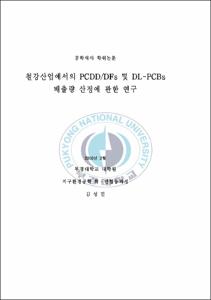철강산업에서의 PCDD/DFs 및 DL-PCBs 배출량 산정에 관한 연구
- Abstract
- With the Stockholm convention coming into effect in 2001, there have been a number of collaborative efforts to identify and characterize the release of "Unintentional Persistent Organic Pollutants"(U-POPs) such as PCDD/DFs and DL-PCBs. And the international organizations and developed countries also make the development and implementation of action plants to decrease them continuously and, where feasible, eliminate them ultimately in the future.
Recently in Korea according as emissions of U-POPs for waste incineration plants decreases , emissions of U-POPs for the industry equipment increases relatively, especially it was reported that among others, the iron and steel industry was very highly occupied(Ministry of Environment, 2005b;2007a).
Therefore, this study is aimed to characterize the emission of U-POPs for the iron and steel industry, and to compare emission factors and emissions considering the influence of various factors.
The results were summarized as followings.
First, the Correlation coefficient of PCDD/DFs and DL-PCBs was over 0.77 in the most of subcategories. And average emitted concentrations of PCDD/DFs and DL-PCBs were 0.550(n=34, ±0.573) ng WHO-TEQ/Sm3 and 0.035(n=30, ±0.037) ng WHO-TEQ/Sm3 for 'Integrated iron and steel - sintering oven', 0.017(n=8, ±0.010) ng WHO-TEQ/Sm3 and 0.001(n=6, ±0.002) ng WHO-TEQ/Sm3 for 'Integrated iron and steel - coke oven', 0.155(n=8, ±0.148) ng WHO-TEQ/Sm3 and 0.025(n=6, ±0.018) ng WHO-TEQ/Sm3 for 'Integrated iron and steel - electric steel furnace', 0.197(n=48, ±0.402) ng WHO-TEQ/Sm3 and 0.020(n=35, ±0.033) ng WHO-TEQ/Sm3 for 'Iron/steel - electric steel furnace', 0.021(n=9, ±0.020) ng WHO-TEQ/Sm3 and 0.021(n=6, ±0.045) ng WHO-TEQ/Sm3 for 'Alloy iron - electric steel furnace', 0.040(n=31, ±0.053) ng WHO-TEQ/Sm3 and 0.005(n=22, ±0.009) ng WHO-TEQ/Sm3 for 'Iron/steel casting - pig iron casting' and 0.023(n=7, ±0.026) ng WHO-TEQ/Sm3 and 0.003(n=6, ±0.003) ng WHO-TEQ/Sm3 for 'Iron/steel casting - steel casting'. The emission concentrations from sintering oven and electric steel furnace are similar to Japan.
Second, the early period of the research in 2001, relative errors of Semi Bottom-up Approach and Top-down Approach for U-POPs emissions were about 30~40%, and the error ratio was downed to about 10% when a ratio of actual research comes at 57.9% in 2007. The more a ratio of actual research increases, the less relative errors of Semi Bottom-up Approach and Top-down Approach, so the Top-down Approach for U-POPs emissions can be used in early future if further actual researches are performed.
Third, it was shown that the representative emission factor excluding outliers can counterbalance the overvaluation of missing value, also the weighted average was more commensurate with emissions of U-POPs than the arithmetic mean because the former is estimated with regards to product outputs, which are very important factors in the emission.
Last, also emission concentrations of U-POPs was decreased significantly after improvement of pollution control facilities. After improvement of pollution control facilities, it was shown that emission concentration was decreased about 80~90% for PCDD/DFs, and about 65~85% for DL-PCBs, respectively. In conclusion, that emission factors must be adopted separately in accordance with change of process for each emission sources.
- Issued Date
- 2010
- Awarded Date
- 2010. 2
- Type
- Dissertation
- Keyword
- 철강산업
- Publisher
- 부경대학교
- Files in This Item:
-
-
Download
 DFs 및 DL-PCBs 배출량 산정에 관한 연구.pdf
기타 데이터 / 680.8 kB / Adobe PDF
DFs 및 DL-PCBs 배출량 산정에 관한 연구.pdf
기타 데이터 / 680.8 kB / Adobe PDF
-
Items in Repository are protected by copyright, with all rights reserved, unless otherwise indicated.